Developing a Professional Practice Portfolio: Nursing Report
VerifiedAdded on 2023/04/05
|12
|2828
|92
Report
AI Summary
This report presents a professional practice portfolio, outlining its components and benefits for nursing professionals. It argues for the portfolio's use in demonstrating professional capabilities, emphasizing its role in documenting achievements, skills, and experiences. The report includes a discussion on leadership and management skills, detailing the importance of these skills for nursing professionals and how the student developed them through workshops and placements. It also examines a professional standard scenario involving an ethical dilemma related to patient autonomy and beneficence, analyzing the nurse's decision-making process and adherence to NMBA professional standards. The report highlights the importance of accountability, critical analysis, and therapeutic relationships in providing quality patient care.
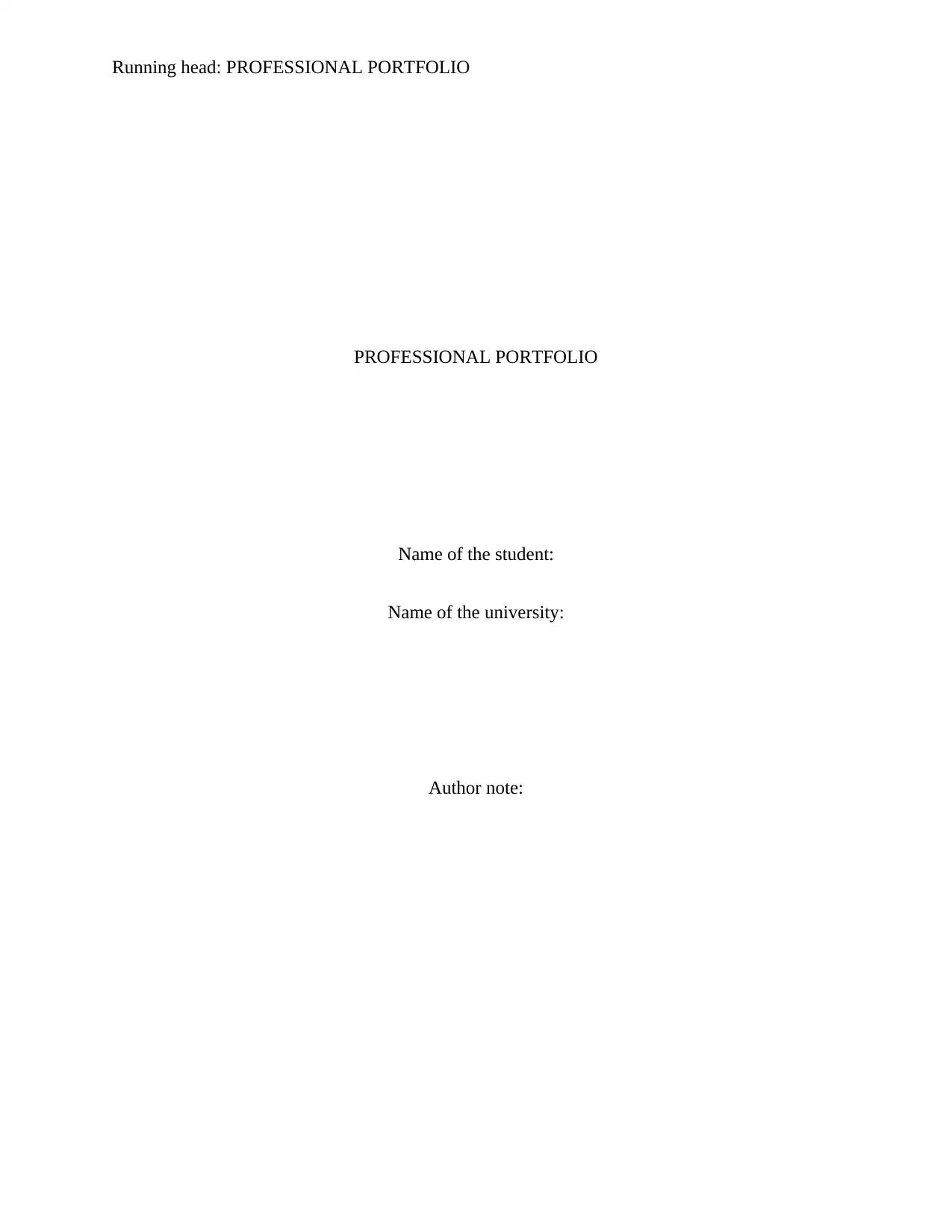
Running head: PROFESSIONAL PORTFOLIO
PROFESSIONAL PORTFOLIO
Name of the student:
Name of the university:
Author note:
PROFESSIONAL PORTFOLIO
Name of the student:
Name of the university:
Author note:
Paraphrase This Document
Need a fresh take? Get an instant paraphrase of this document with our AI Paraphraser
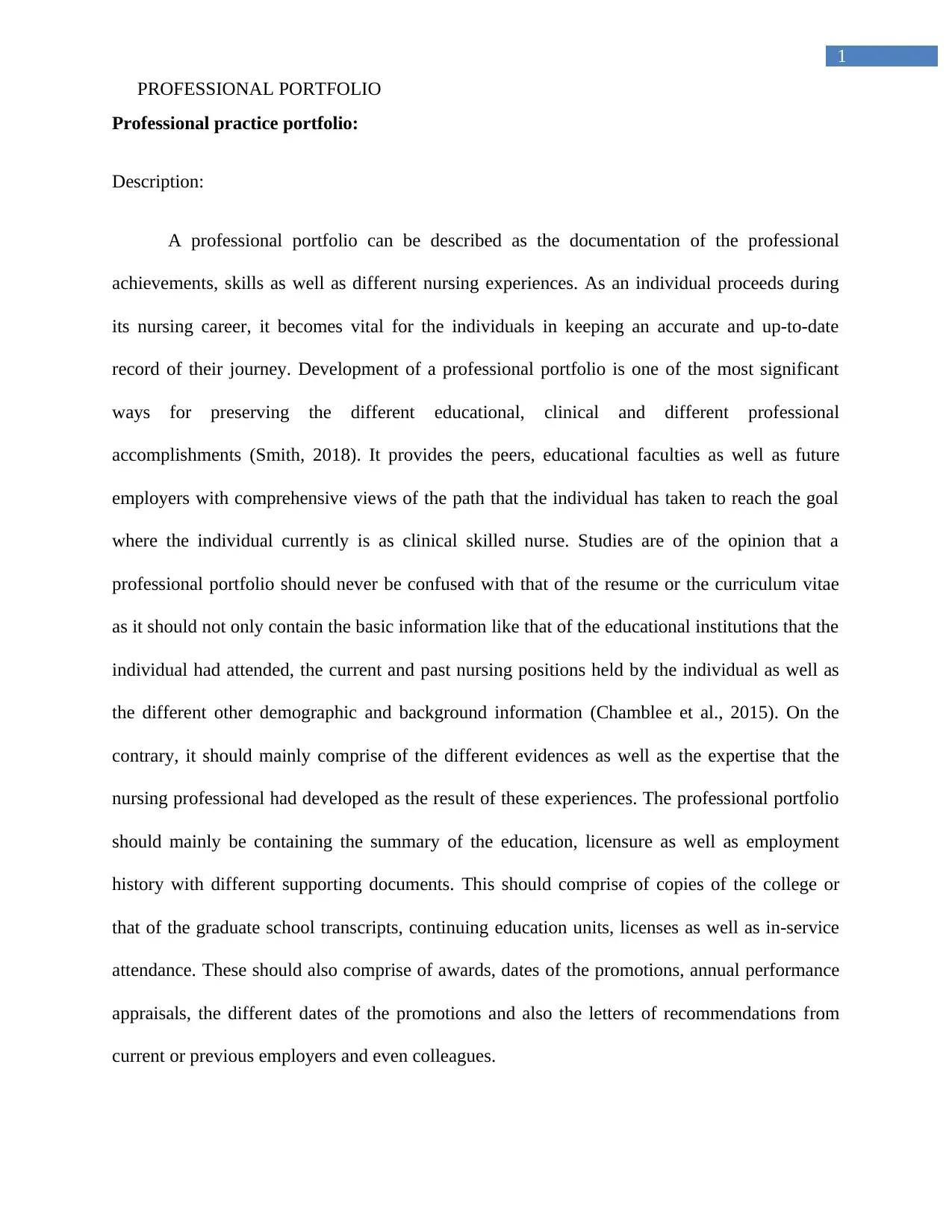
1
PROFESSIONAL PORTFOLIO
Professional practice portfolio:
Description:
A professional portfolio can be described as the documentation of the professional
achievements, skills as well as different nursing experiences. As an individual proceeds during
its nursing career, it becomes vital for the individuals in keeping an accurate and up-to-date
record of their journey. Development of a professional portfolio is one of the most significant
ways for preserving the different educational, clinical and different professional
accomplishments (Smith, 2018). It provides the peers, educational faculties as well as future
employers with comprehensive views of the path that the individual has taken to reach the goal
where the individual currently is as clinical skilled nurse. Studies are of the opinion that a
professional portfolio should never be confused with that of the resume or the curriculum vitae
as it should not only contain the basic information like that of the educational institutions that the
individual had attended, the current and past nursing positions held by the individual as well as
the different other demographic and background information (Chamblee et al., 2015). On the
contrary, it should mainly comprise of the different evidences as well as the expertise that the
nursing professional had developed as the result of these experiences. The professional portfolio
should mainly be containing the summary of the education, licensure as well as employment
history with different supporting documents. This should comprise of copies of the college or
that of the graduate school transcripts, continuing education units, licenses as well as in-service
attendance. These should also comprise of awards, dates of the promotions, annual performance
appraisals, the different dates of the promotions and also the letters of recommendations from
current or previous employers and even colleagues.
PROFESSIONAL PORTFOLIO
Professional practice portfolio:
Description:
A professional portfolio can be described as the documentation of the professional
achievements, skills as well as different nursing experiences. As an individual proceeds during
its nursing career, it becomes vital for the individuals in keeping an accurate and up-to-date
record of their journey. Development of a professional portfolio is one of the most significant
ways for preserving the different educational, clinical and different professional
accomplishments (Smith, 2018). It provides the peers, educational faculties as well as future
employers with comprehensive views of the path that the individual has taken to reach the goal
where the individual currently is as clinical skilled nurse. Studies are of the opinion that a
professional portfolio should never be confused with that of the resume or the curriculum vitae
as it should not only contain the basic information like that of the educational institutions that the
individual had attended, the current and past nursing positions held by the individual as well as
the different other demographic and background information (Chamblee et al., 2015). On the
contrary, it should mainly comprise of the different evidences as well as the expertise that the
nursing professional had developed as the result of these experiences. The professional portfolio
should mainly be containing the summary of the education, licensure as well as employment
history with different supporting documents. This should comprise of copies of the college or
that of the graduate school transcripts, continuing education units, licenses as well as in-service
attendance. These should also comprise of awards, dates of the promotions, annual performance
appraisals, the different dates of the promotions and also the letters of recommendations from
current or previous employers and even colleagues.
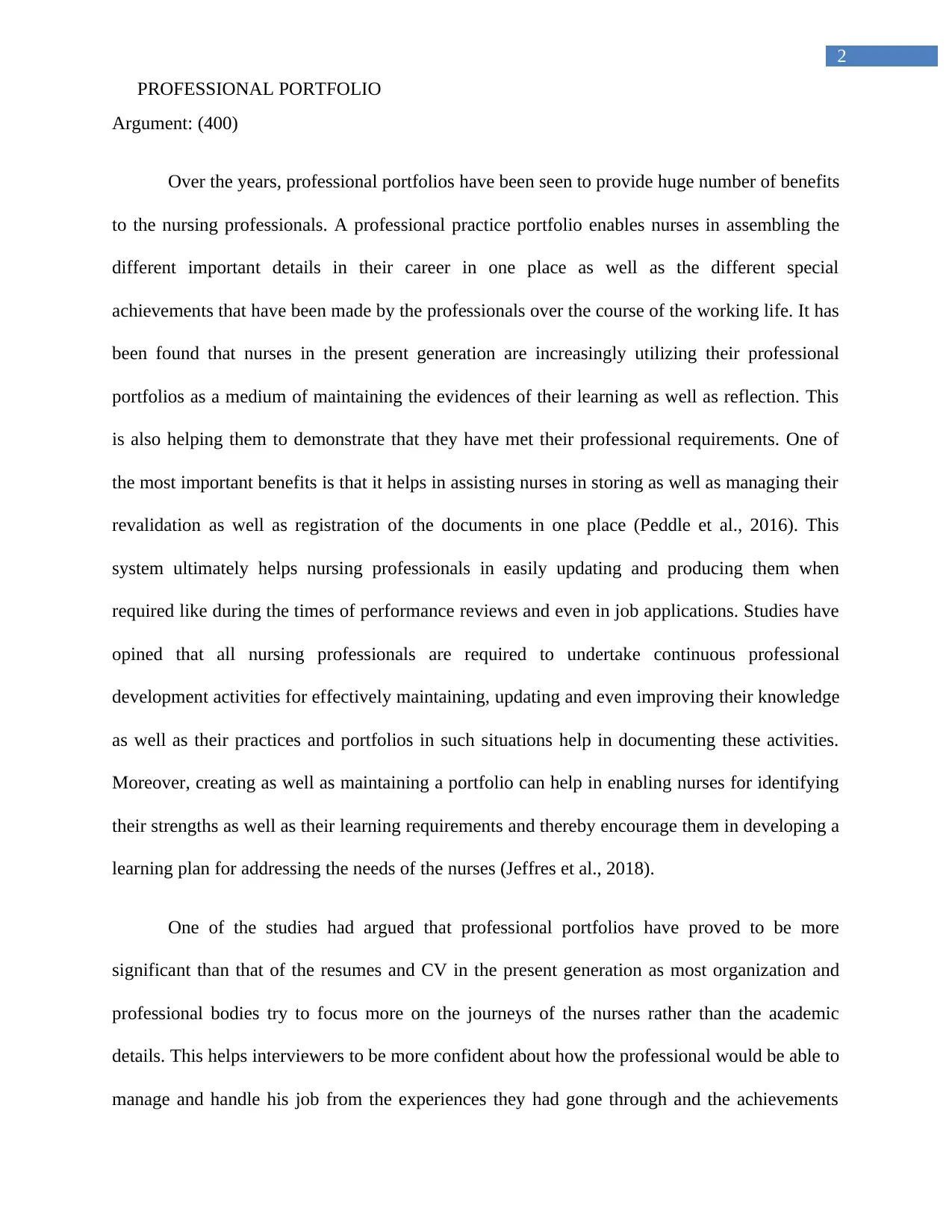
2
PROFESSIONAL PORTFOLIO
Argument: (400)
Over the years, professional portfolios have been seen to provide huge number of benefits
to the nursing professionals. A professional practice portfolio enables nurses in assembling the
different important details in their career in one place as well as the different special
achievements that have been made by the professionals over the course of the working life. It has
been found that nurses in the present generation are increasingly utilizing their professional
portfolios as a medium of maintaining the evidences of their learning as well as reflection. This
is also helping them to demonstrate that they have met their professional requirements. One of
the most important benefits is that it helps in assisting nurses in storing as well as managing their
revalidation as well as registration of the documents in one place (Peddle et al., 2016). This
system ultimately helps nursing professionals in easily updating and producing them when
required like during the times of performance reviews and even in job applications. Studies have
opined that all nursing professionals are required to undertake continuous professional
development activities for effectively maintaining, updating and even improving their knowledge
as well as their practices and portfolios in such situations help in documenting these activities.
Moreover, creating as well as maintaining a portfolio can help in enabling nurses for identifying
their strengths as well as their learning requirements and thereby encourage them in developing a
learning plan for addressing the needs of the nurses (Jeffres et al., 2018).
One of the studies had argued that professional portfolios have proved to be more
significant than that of the resumes and CV in the present generation as most organization and
professional bodies try to focus more on the journeys of the nurses rather than the academic
details. This helps interviewers to be more confident about how the professional would be able to
manage and handle his job from the experiences they had gone through and the achievements
PROFESSIONAL PORTFOLIO
Argument: (400)
Over the years, professional portfolios have been seen to provide huge number of benefits
to the nursing professionals. A professional practice portfolio enables nurses in assembling the
different important details in their career in one place as well as the different special
achievements that have been made by the professionals over the course of the working life. It has
been found that nurses in the present generation are increasingly utilizing their professional
portfolios as a medium of maintaining the evidences of their learning as well as reflection. This
is also helping them to demonstrate that they have met their professional requirements. One of
the most important benefits is that it helps in assisting nurses in storing as well as managing their
revalidation as well as registration of the documents in one place (Peddle et al., 2016). This
system ultimately helps nursing professionals in easily updating and producing them when
required like during the times of performance reviews and even in job applications. Studies have
opined that all nursing professionals are required to undertake continuous professional
development activities for effectively maintaining, updating and even improving their knowledge
as well as their practices and portfolios in such situations help in documenting these activities.
Moreover, creating as well as maintaining a portfolio can help in enabling nurses for identifying
their strengths as well as their learning requirements and thereby encourage them in developing a
learning plan for addressing the needs of the nurses (Jeffres et al., 2018).
One of the studies had argued that professional portfolios have proved to be more
significant than that of the resumes and CV in the present generation as most organization and
professional bodies try to focus more on the journeys of the nurses rather than the academic
details. This helps interviewers to be more confident about how the professional would be able to
manage and handle his job from the experiences they had gone through and the achievements
⊘ This is a preview!⊘
Do you want full access?
Subscribe today to unlock all pages.

Trusted by 1+ million students worldwide
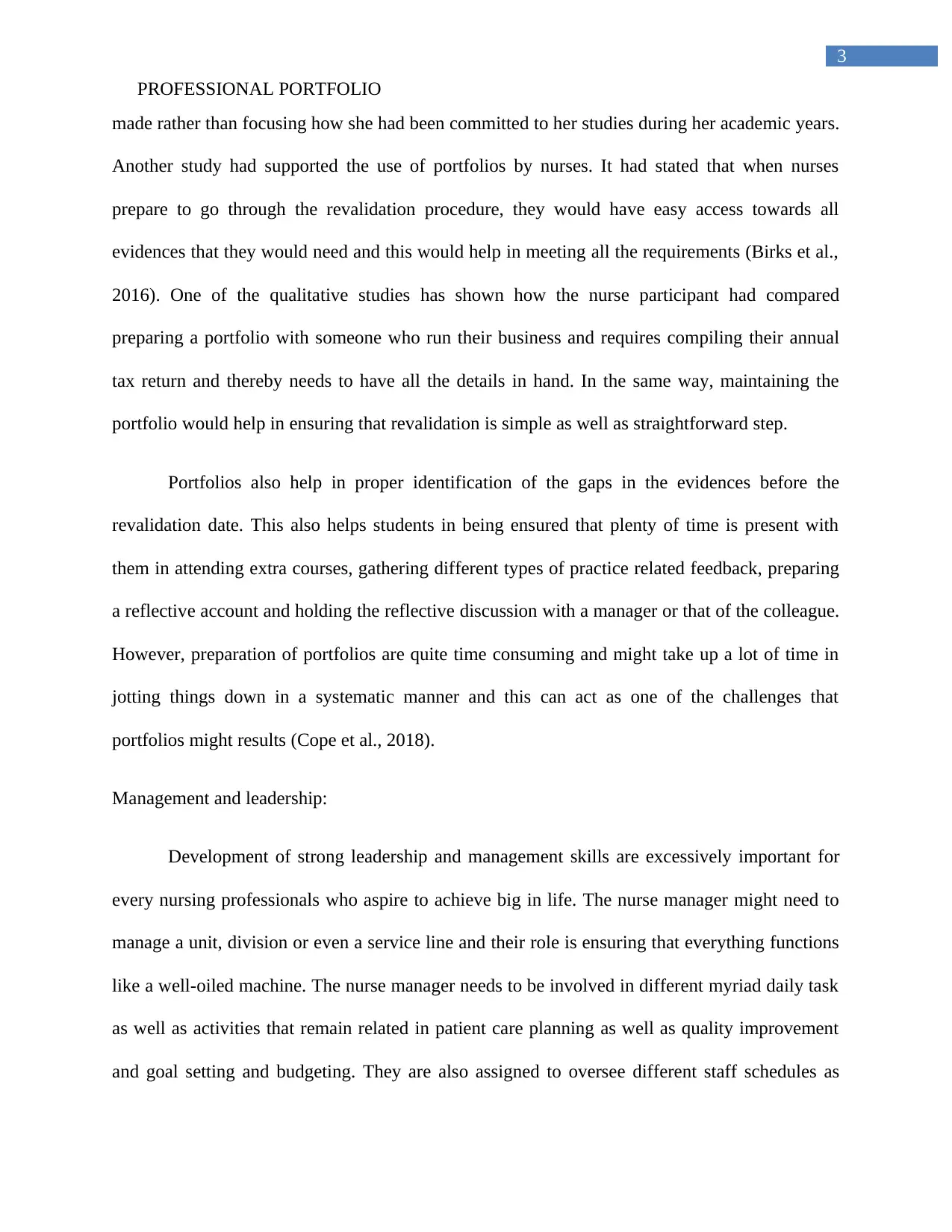
3
PROFESSIONAL PORTFOLIO
made rather than focusing how she had been committed to her studies during her academic years.
Another study had supported the use of portfolios by nurses. It had stated that when nurses
prepare to go through the revalidation procedure, they would have easy access towards all
evidences that they would need and this would help in meeting all the requirements (Birks et al.,
2016). One of the qualitative studies has shown how the nurse participant had compared
preparing a portfolio with someone who run their business and requires compiling their annual
tax return and thereby needs to have all the details in hand. In the same way, maintaining the
portfolio would help in ensuring that revalidation is simple as well as straightforward step.
Portfolios also help in proper identification of the gaps in the evidences before the
revalidation date. This also helps students in being ensured that plenty of time is present with
them in attending extra courses, gathering different types of practice related feedback, preparing
a reflective account and holding the reflective discussion with a manager or that of the colleague.
However, preparation of portfolios are quite time consuming and might take up a lot of time in
jotting things down in a systematic manner and this can act as one of the challenges that
portfolios might results (Cope et al., 2018).
Management and leadership:
Development of strong leadership and management skills are excessively important for
every nursing professionals who aspire to achieve big in life. The nurse manager might need to
manage a unit, division or even a service line and their role is ensuring that everything functions
like a well-oiled machine. The nurse manager needs to be involved in different myriad daily task
as well as activities that remain related in patient care planning as well as quality improvement
and goal setting and budgeting. They are also assigned to oversee different staff schedules as
PROFESSIONAL PORTFOLIO
made rather than focusing how she had been committed to her studies during her academic years.
Another study had supported the use of portfolios by nurses. It had stated that when nurses
prepare to go through the revalidation procedure, they would have easy access towards all
evidences that they would need and this would help in meeting all the requirements (Birks et al.,
2016). One of the qualitative studies has shown how the nurse participant had compared
preparing a portfolio with someone who run their business and requires compiling their annual
tax return and thereby needs to have all the details in hand. In the same way, maintaining the
portfolio would help in ensuring that revalidation is simple as well as straightforward step.
Portfolios also help in proper identification of the gaps in the evidences before the
revalidation date. This also helps students in being ensured that plenty of time is present with
them in attending extra courses, gathering different types of practice related feedback, preparing
a reflective account and holding the reflective discussion with a manager or that of the colleague.
However, preparation of portfolios are quite time consuming and might take up a lot of time in
jotting things down in a systematic manner and this can act as one of the challenges that
portfolios might results (Cope et al., 2018).
Management and leadership:
Development of strong leadership and management skills are excessively important for
every nursing professionals who aspire to achieve big in life. The nurse manager might need to
manage a unit, division or even a service line and their role is ensuring that everything functions
like a well-oiled machine. The nurse manager needs to be involved in different myriad daily task
as well as activities that remain related in patient care planning as well as quality improvement
and goal setting and budgeting. They are also assigned to oversee different staff schedules as
Paraphrase This Document
Need a fresh take? Get an instant paraphrase of this document with our AI Paraphraser
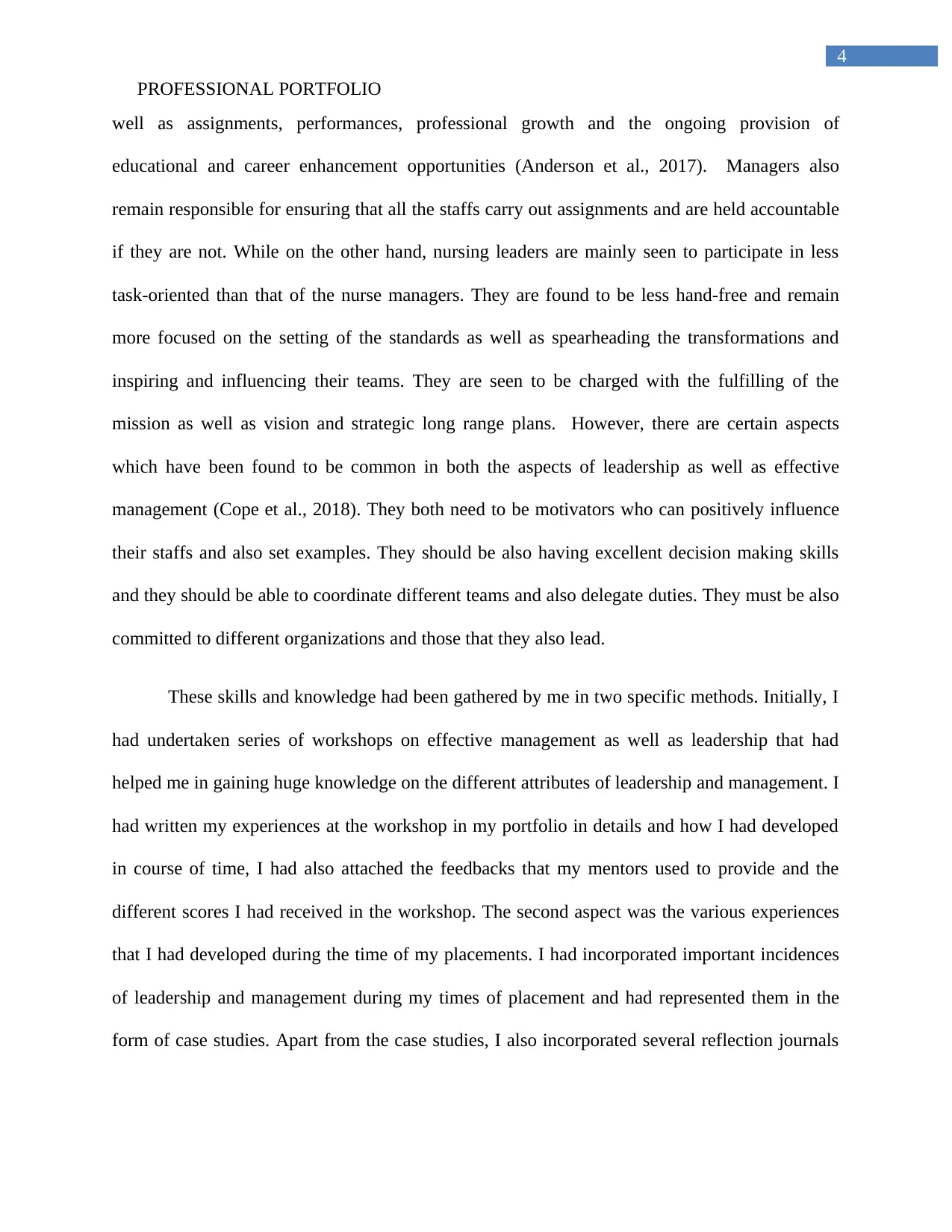
4
PROFESSIONAL PORTFOLIO
well as assignments, performances, professional growth and the ongoing provision of
educational and career enhancement opportunities (Anderson et al., 2017). Managers also
remain responsible for ensuring that all the staffs carry out assignments and are held accountable
if they are not. While on the other hand, nursing leaders are mainly seen to participate in less
task-oriented than that of the nurse managers. They are found to be less hand-free and remain
more focused on the setting of the standards as well as spearheading the transformations and
inspiring and influencing their teams. They are seen to be charged with the fulfilling of the
mission as well as vision and strategic long range plans. However, there are certain aspects
which have been found to be common in both the aspects of leadership as well as effective
management (Cope et al., 2018). They both need to be motivators who can positively influence
their staffs and also set examples. They should be also having excellent decision making skills
and they should be able to coordinate different teams and also delegate duties. They must be also
committed to different organizations and those that they also lead.
These skills and knowledge had been gathered by me in two specific methods. Initially, I
had undertaken series of workshops on effective management as well as leadership that had
helped me in gaining huge knowledge on the different attributes of leadership and management. I
had written my experiences at the workshop in my portfolio in details and how I had developed
in course of time, I had also attached the feedbacks that my mentors used to provide and the
different scores I had received in the workshop. The second aspect was the various experiences
that I had developed during the time of my placements. I had incorporated important incidences
of leadership and management during my times of placement and had represented them in the
form of case studies. Apart from the case studies, I also incorporated several reflection journals
PROFESSIONAL PORTFOLIO
well as assignments, performances, professional growth and the ongoing provision of
educational and career enhancement opportunities (Anderson et al., 2017). Managers also
remain responsible for ensuring that all the staffs carry out assignments and are held accountable
if they are not. While on the other hand, nursing leaders are mainly seen to participate in less
task-oriented than that of the nurse managers. They are found to be less hand-free and remain
more focused on the setting of the standards as well as spearheading the transformations and
inspiring and influencing their teams. They are seen to be charged with the fulfilling of the
mission as well as vision and strategic long range plans. However, there are certain aspects
which have been found to be common in both the aspects of leadership as well as effective
management (Cope et al., 2018). They both need to be motivators who can positively influence
their staffs and also set examples. They should be also having excellent decision making skills
and they should be able to coordinate different teams and also delegate duties. They must be also
committed to different organizations and those that they also lead.
These skills and knowledge had been gathered by me in two specific methods. Initially, I
had undertaken series of workshops on effective management as well as leadership that had
helped me in gaining huge knowledge on the different attributes of leadership and management. I
had written my experiences at the workshop in my portfolio in details and how I had developed
in course of time, I had also attached the feedbacks that my mentors used to provide and the
different scores I had received in the workshop. The second aspect was the various experiences
that I had developed during the time of my placements. I had incorporated important incidences
of leadership and management during my times of placement and had represented them in the
form of case studies. Apart from the case studies, I also incorporated several reflection journals
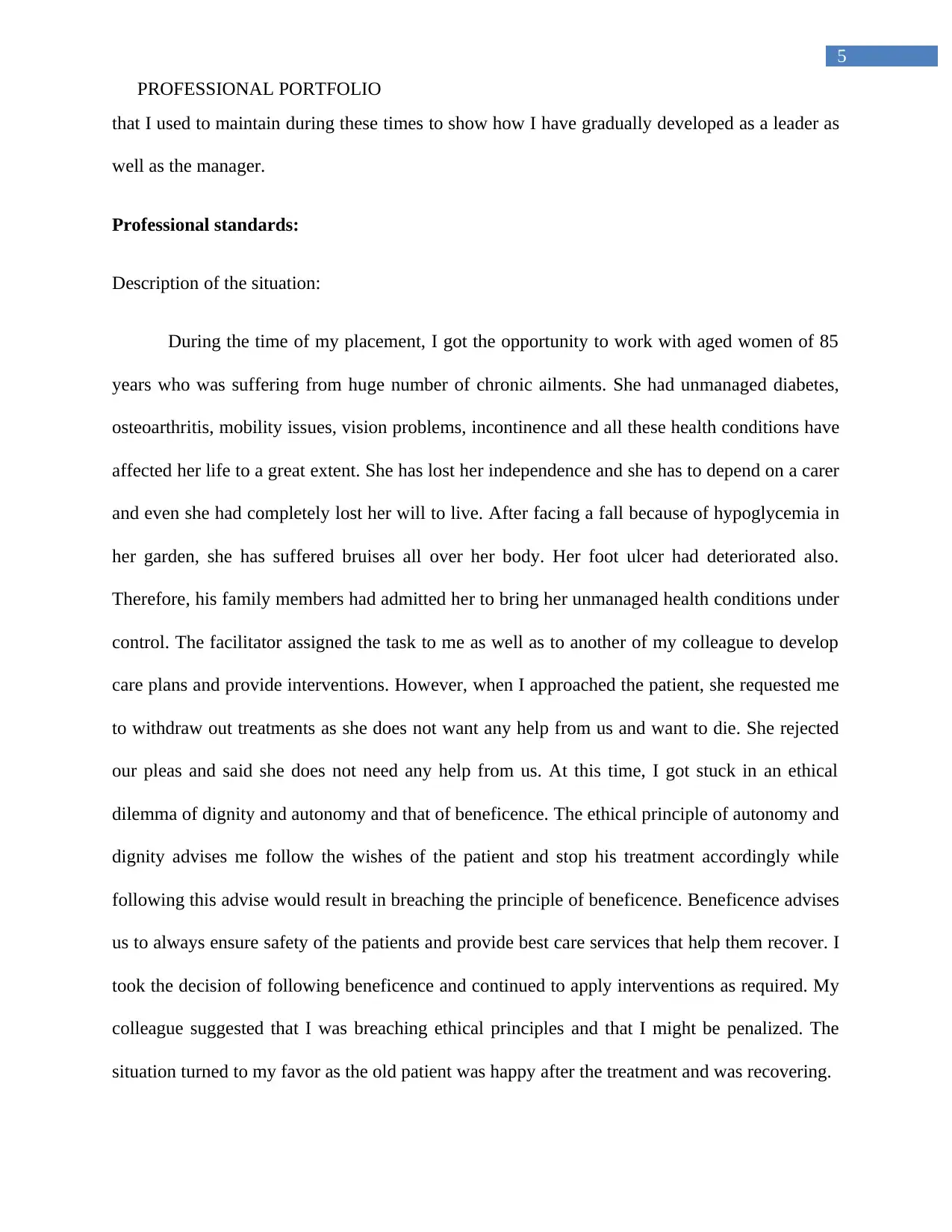
5
PROFESSIONAL PORTFOLIO
that I used to maintain during these times to show how I have gradually developed as a leader as
well as the manager.
Professional standards:
Description of the situation:
During the time of my placement, I got the opportunity to work with aged women of 85
years who was suffering from huge number of chronic ailments. She had unmanaged diabetes,
osteoarthritis, mobility issues, vision problems, incontinence and all these health conditions have
affected her life to a great extent. She has lost her independence and she has to depend on a carer
and even she had completely lost her will to live. After facing a fall because of hypoglycemia in
her garden, she has suffered bruises all over her body. Her foot ulcer had deteriorated also.
Therefore, his family members had admitted her to bring her unmanaged health conditions under
control. The facilitator assigned the task to me as well as to another of my colleague to develop
care plans and provide interventions. However, when I approached the patient, she requested me
to withdraw out treatments as she does not want any help from us and want to die. She rejected
our pleas and said she does not need any help from us. At this time, I got stuck in an ethical
dilemma of dignity and autonomy and that of beneficence. The ethical principle of autonomy and
dignity advises me follow the wishes of the patient and stop his treatment accordingly while
following this advise would result in breaching the principle of beneficence. Beneficence advises
us to always ensure safety of the patients and provide best care services that help them recover. I
took the decision of following beneficence and continued to apply interventions as required. My
colleague suggested that I was breaching ethical principles and that I might be penalized. The
situation turned to my favor as the old patient was happy after the treatment and was recovering.
PROFESSIONAL PORTFOLIO
that I used to maintain during these times to show how I have gradually developed as a leader as
well as the manager.
Professional standards:
Description of the situation:
During the time of my placement, I got the opportunity to work with aged women of 85
years who was suffering from huge number of chronic ailments. She had unmanaged diabetes,
osteoarthritis, mobility issues, vision problems, incontinence and all these health conditions have
affected her life to a great extent. She has lost her independence and she has to depend on a carer
and even she had completely lost her will to live. After facing a fall because of hypoglycemia in
her garden, she has suffered bruises all over her body. Her foot ulcer had deteriorated also.
Therefore, his family members had admitted her to bring her unmanaged health conditions under
control. The facilitator assigned the task to me as well as to another of my colleague to develop
care plans and provide interventions. However, when I approached the patient, she requested me
to withdraw out treatments as she does not want any help from us and want to die. She rejected
our pleas and said she does not need any help from us. At this time, I got stuck in an ethical
dilemma of dignity and autonomy and that of beneficence. The ethical principle of autonomy and
dignity advises me follow the wishes of the patient and stop his treatment accordingly while
following this advise would result in breaching the principle of beneficence. Beneficence advises
us to always ensure safety of the patients and provide best care services that help them recover. I
took the decision of following beneficence and continued to apply interventions as required. My
colleague suggested that I was breaching ethical principles and that I might be penalized. The
situation turned to my favor as the old patient was happy after the treatment and was recovering.
⊘ This is a preview!⊘
Do you want full access?
Subscribe today to unlock all pages.

Trusted by 1+ million students worldwide
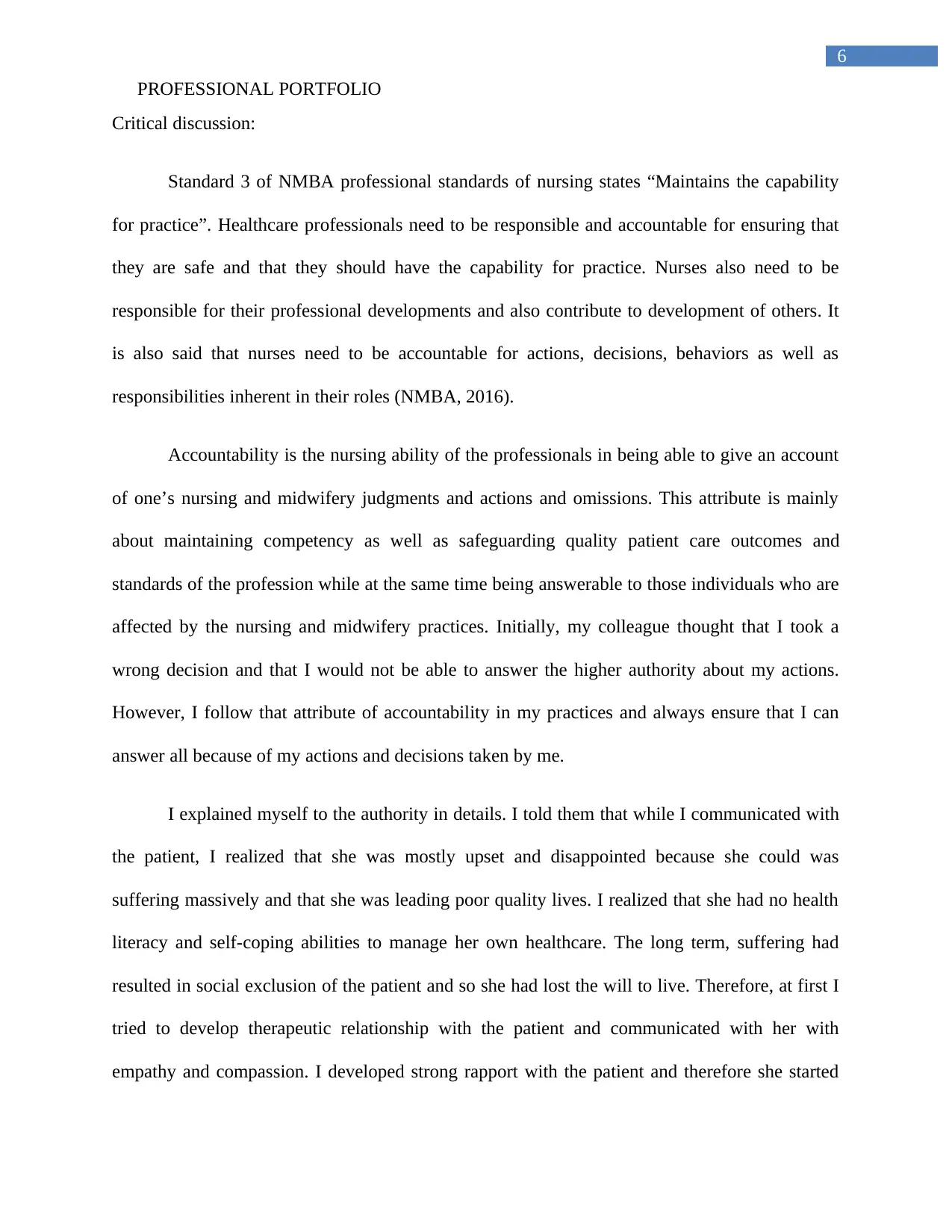
6
PROFESSIONAL PORTFOLIO
Critical discussion:
Standard 3 of NMBA professional standards of nursing states “Maintains the capability
for practice”. Healthcare professionals need to be responsible and accountable for ensuring that
they are safe and that they should have the capability for practice. Nurses also need to be
responsible for their professional developments and also contribute to development of others. It
is also said that nurses need to be accountable for actions, decisions, behaviors as well as
responsibilities inherent in their roles (NMBA, 2016).
Accountability is the nursing ability of the professionals in being able to give an account
of one’s nursing and midwifery judgments and actions and omissions. This attribute is mainly
about maintaining competency as well as safeguarding quality patient care outcomes and
standards of the profession while at the same time being answerable to those individuals who are
affected by the nursing and midwifery practices. Initially, my colleague thought that I took a
wrong decision and that I would not be able to answer the higher authority about my actions.
However, I follow that attribute of accountability in my practices and always ensure that I can
answer all because of my actions and decisions taken by me.
I explained myself to the authority in details. I told them that while I communicated with
the patient, I realized that she was mostly upset and disappointed because she could was
suffering massively and that she was leading poor quality lives. I realized that she had no health
literacy and self-coping abilities to manage her own healthcare. The long term, suffering had
resulted in social exclusion of the patient and so she had lost the will to live. Therefore, at first I
tried to develop therapeutic relationship with the patient and communicated with her with
empathy and compassion. I developed strong rapport with the patient and therefore she started
PROFESSIONAL PORTFOLIO
Critical discussion:
Standard 3 of NMBA professional standards of nursing states “Maintains the capability
for practice”. Healthcare professionals need to be responsible and accountable for ensuring that
they are safe and that they should have the capability for practice. Nurses also need to be
responsible for their professional developments and also contribute to development of others. It
is also said that nurses need to be accountable for actions, decisions, behaviors as well as
responsibilities inherent in their roles (NMBA, 2016).
Accountability is the nursing ability of the professionals in being able to give an account
of one’s nursing and midwifery judgments and actions and omissions. This attribute is mainly
about maintaining competency as well as safeguarding quality patient care outcomes and
standards of the profession while at the same time being answerable to those individuals who are
affected by the nursing and midwifery practices. Initially, my colleague thought that I took a
wrong decision and that I would not be able to answer the higher authority about my actions.
However, I follow that attribute of accountability in my practices and always ensure that I can
answer all because of my actions and decisions taken by me.
I explained myself to the authority in details. I told them that while I communicated with
the patient, I realized that she was mostly upset and disappointed because she could was
suffering massively and that she was leading poor quality lives. I realized that she had no health
literacy and self-coping abilities to manage her own healthcare. The long term, suffering had
resulted in social exclusion of the patient and so she had lost the will to live. Therefore, at first I
tried to develop therapeutic relationship with the patient and communicated with her with
empathy and compassion. I developed strong rapport with the patient and therefore she started
Paraphrase This Document
Need a fresh take? Get an instant paraphrase of this document with our AI Paraphraser
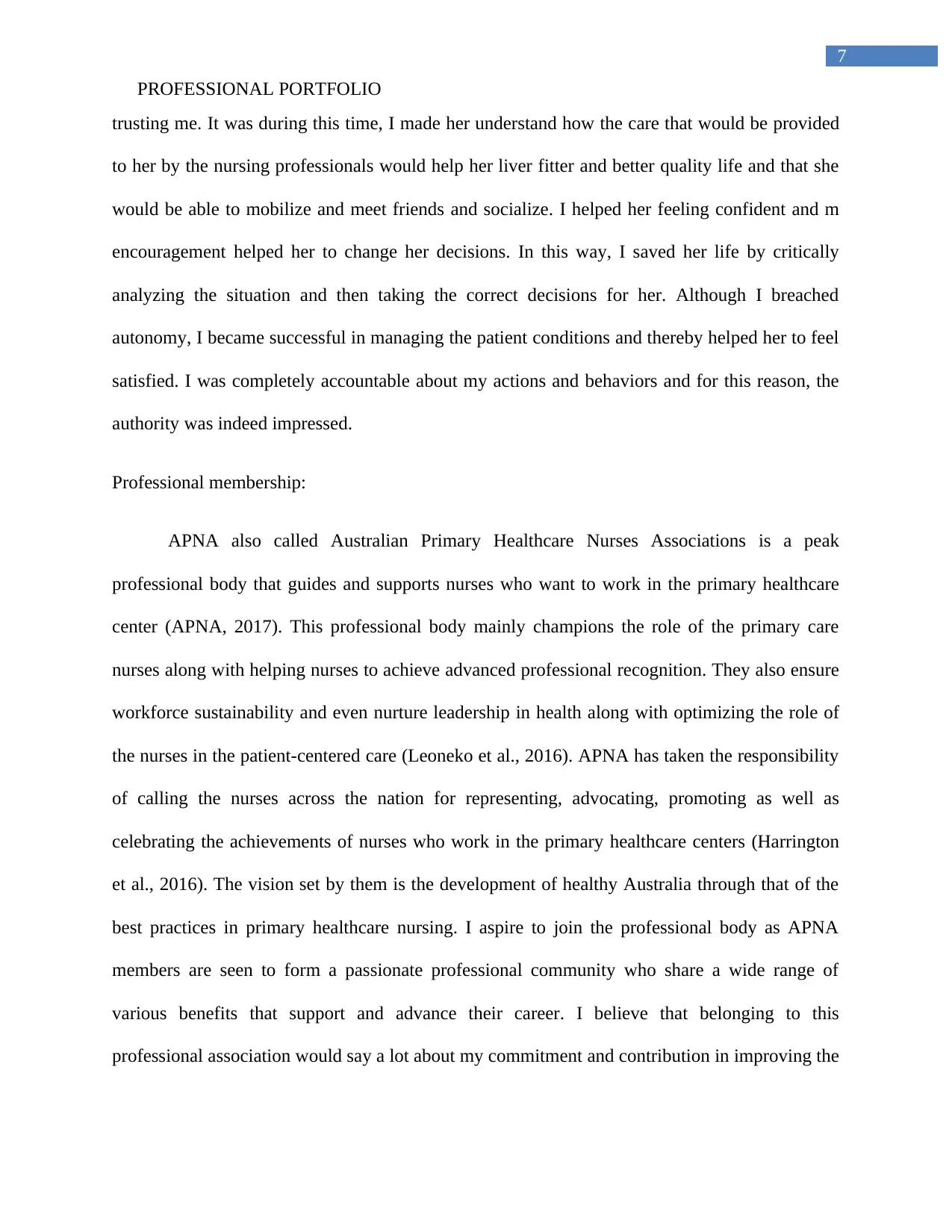
7
PROFESSIONAL PORTFOLIO
trusting me. It was during this time, I made her understand how the care that would be provided
to her by the nursing professionals would help her liver fitter and better quality life and that she
would be able to mobilize and meet friends and socialize. I helped her feeling confident and m
encouragement helped her to change her decisions. In this way, I saved her life by critically
analyzing the situation and then taking the correct decisions for her. Although I breached
autonomy, I became successful in managing the patient conditions and thereby helped her to feel
satisfied. I was completely accountable about my actions and behaviors and for this reason, the
authority was indeed impressed.
Professional membership:
APNA also called Australian Primary Healthcare Nurses Associations is a peak
professional body that guides and supports nurses who want to work in the primary healthcare
center (APNA, 2017). This professional body mainly champions the role of the primary care
nurses along with helping nurses to achieve advanced professional recognition. They also ensure
workforce sustainability and even nurture leadership in health along with optimizing the role of
the nurses in the patient-centered care (Leoneko et al., 2016). APNA has taken the responsibility
of calling the nurses across the nation for representing, advocating, promoting as well as
celebrating the achievements of nurses who work in the primary healthcare centers (Harrington
et al., 2016). The vision set by them is the development of healthy Australia through that of the
best practices in primary healthcare nursing. I aspire to join the professional body as APNA
members are seen to form a passionate professional community who share a wide range of
various benefits that support and advance their career. I believe that belonging to this
professional association would say a lot about my commitment and contribution in improving the
PROFESSIONAL PORTFOLIO
trusting me. It was during this time, I made her understand how the care that would be provided
to her by the nursing professionals would help her liver fitter and better quality life and that she
would be able to mobilize and meet friends and socialize. I helped her feeling confident and m
encouragement helped her to change her decisions. In this way, I saved her life by critically
analyzing the situation and then taking the correct decisions for her. Although I breached
autonomy, I became successful in managing the patient conditions and thereby helped her to feel
satisfied. I was completely accountable about my actions and behaviors and for this reason, the
authority was indeed impressed.
Professional membership:
APNA also called Australian Primary Healthcare Nurses Associations is a peak
professional body that guides and supports nurses who want to work in the primary healthcare
center (APNA, 2017). This professional body mainly champions the role of the primary care
nurses along with helping nurses to achieve advanced professional recognition. They also ensure
workforce sustainability and even nurture leadership in health along with optimizing the role of
the nurses in the patient-centered care (Leoneko et al., 2016). APNA has taken the responsibility
of calling the nurses across the nation for representing, advocating, promoting as well as
celebrating the achievements of nurses who work in the primary healthcare centers (Harrington
et al., 2016). The vision set by them is the development of healthy Australia through that of the
best practices in primary healthcare nursing. I aspire to join the professional body as APNA
members are seen to form a passionate professional community who share a wide range of
various benefits that support and advance their career. I believe that belonging to this
professional association would say a lot about my commitment and contribution in improving the
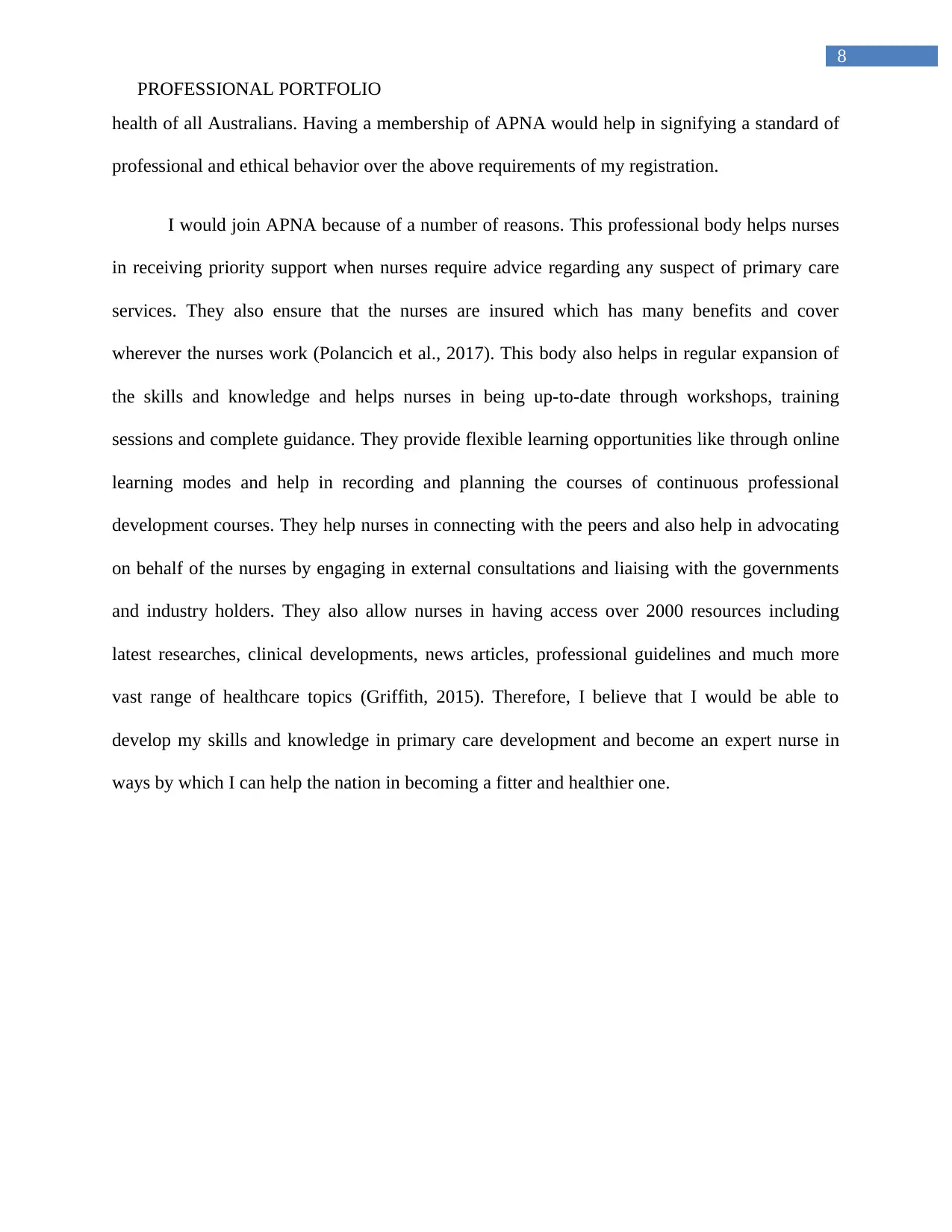
8
PROFESSIONAL PORTFOLIO
health of all Australians. Having a membership of APNA would help in signifying a standard of
professional and ethical behavior over the above requirements of my registration.
I would join APNA because of a number of reasons. This professional body helps nurses
in receiving priority support when nurses require advice regarding any suspect of primary care
services. They also ensure that the nurses are insured which has many benefits and cover
wherever the nurses work (Polancich et al., 2017). This body also helps in regular expansion of
the skills and knowledge and helps nurses in being up-to-date through workshops, training
sessions and complete guidance. They provide flexible learning opportunities like through online
learning modes and help in recording and planning the courses of continuous professional
development courses. They help nurses in connecting with the peers and also help in advocating
on behalf of the nurses by engaging in external consultations and liaising with the governments
and industry holders. They also allow nurses in having access over 2000 resources including
latest researches, clinical developments, news articles, professional guidelines and much more
vast range of healthcare topics (Griffith, 2015). Therefore, I believe that I would be able to
develop my skills and knowledge in primary care development and become an expert nurse in
ways by which I can help the nation in becoming a fitter and healthier one.
PROFESSIONAL PORTFOLIO
health of all Australians. Having a membership of APNA would help in signifying a standard of
professional and ethical behavior over the above requirements of my registration.
I would join APNA because of a number of reasons. This professional body helps nurses
in receiving priority support when nurses require advice regarding any suspect of primary care
services. They also ensure that the nurses are insured which has many benefits and cover
wherever the nurses work (Polancich et al., 2017). This body also helps in regular expansion of
the skills and knowledge and helps nurses in being up-to-date through workshops, training
sessions and complete guidance. They provide flexible learning opportunities like through online
learning modes and help in recording and planning the courses of continuous professional
development courses. They help nurses in connecting with the peers and also help in advocating
on behalf of the nurses by engaging in external consultations and liaising with the governments
and industry holders. They also allow nurses in having access over 2000 resources including
latest researches, clinical developments, news articles, professional guidelines and much more
vast range of healthcare topics (Griffith, 2015). Therefore, I believe that I would be able to
develop my skills and knowledge in primary care development and become an expert nurse in
ways by which I can help the nation in becoming a fitter and healthier one.
⊘ This is a preview!⊘
Do you want full access?
Subscribe today to unlock all pages.

Trusted by 1+ million students worldwide
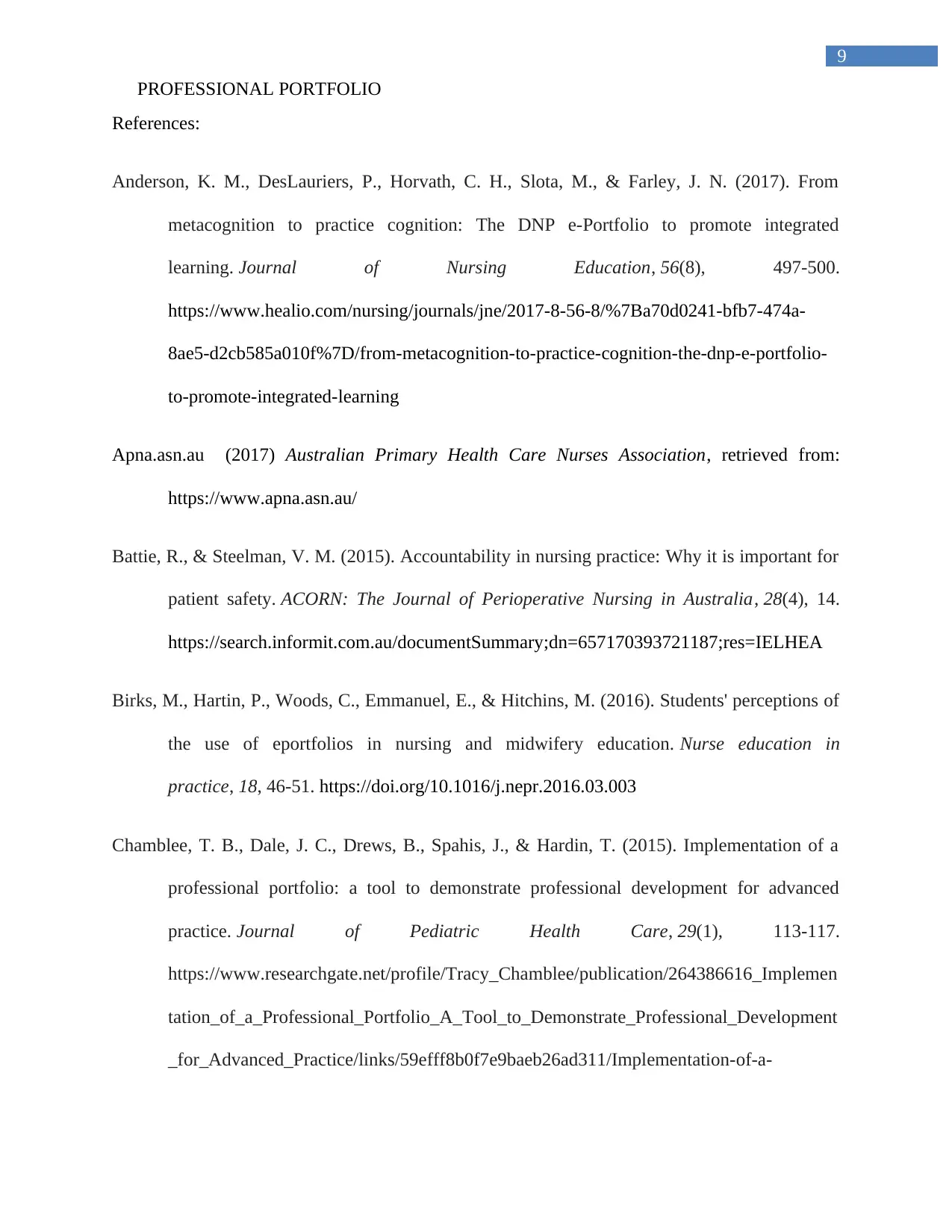
9
PROFESSIONAL PORTFOLIO
References:
Anderson, K. M., DesLauriers, P., Horvath, C. H., Slota, M., & Farley, J. N. (2017). From
metacognition to practice cognition: The DNP e-Portfolio to promote integrated
learning. Journal of Nursing Education, 56(8), 497-500.
https://www.healio.com/nursing/journals/jne/2017-8-56-8/%7Ba70d0241-bfb7-474a-
8ae5-d2cb585a010f%7D/from-metacognition-to-practice-cognition-the-dnp-e-portfolio-
to-promote-integrated-learning
Apna.asn.au (2017) Australian Primary Health Care Nurses Association, retrieved from:
https://www.apna.asn.au/
Battie, R., & Steelman, V. M. (2015). Accountability in nursing practice: Why it is important for
patient safety. ACORN: The Journal of Perioperative Nursing in Australia, 28(4), 14.
https://search.informit.com.au/documentSummary;dn=657170393721187;res=IELHEA
Birks, M., Hartin, P., Woods, C., Emmanuel, E., & Hitchins, M. (2016). Students' perceptions of
the use of eportfolios in nursing and midwifery education. Nurse education in
practice, 18, 46-51. https://doi.org/10.1016/j.nepr.2016.03.003
Chamblee, T. B., Dale, J. C., Drews, B., Spahis, J., & Hardin, T. (2015). Implementation of a
professional portfolio: a tool to demonstrate professional development for advanced
practice. Journal of Pediatric Health Care, 29(1), 113-117.
https://www.researchgate.net/profile/Tracy_Chamblee/publication/264386616_Implemen
tation_of_a_Professional_Portfolio_A_Tool_to_Demonstrate_Professional_Development
_for_Advanced_Practice/links/59efff8b0f7e9baeb26ad311/Implementation-of-a-
PROFESSIONAL PORTFOLIO
References:
Anderson, K. M., DesLauriers, P., Horvath, C. H., Slota, M., & Farley, J. N. (2017). From
metacognition to practice cognition: The DNP e-Portfolio to promote integrated
learning. Journal of Nursing Education, 56(8), 497-500.
https://www.healio.com/nursing/journals/jne/2017-8-56-8/%7Ba70d0241-bfb7-474a-
8ae5-d2cb585a010f%7D/from-metacognition-to-practice-cognition-the-dnp-e-portfolio-
to-promote-integrated-learning
Apna.asn.au (2017) Australian Primary Health Care Nurses Association, retrieved from:
https://www.apna.asn.au/
Battie, R., & Steelman, V. M. (2015). Accountability in nursing practice: Why it is important for
patient safety. ACORN: The Journal of Perioperative Nursing in Australia, 28(4), 14.
https://search.informit.com.au/documentSummary;dn=657170393721187;res=IELHEA
Birks, M., Hartin, P., Woods, C., Emmanuel, E., & Hitchins, M. (2016). Students' perceptions of
the use of eportfolios in nursing and midwifery education. Nurse education in
practice, 18, 46-51. https://doi.org/10.1016/j.nepr.2016.03.003
Chamblee, T. B., Dale, J. C., Drews, B., Spahis, J., & Hardin, T. (2015). Implementation of a
professional portfolio: a tool to demonstrate professional development for advanced
practice. Journal of Pediatric Health Care, 29(1), 113-117.
https://www.researchgate.net/profile/Tracy_Chamblee/publication/264386616_Implemen
tation_of_a_Professional_Portfolio_A_Tool_to_Demonstrate_Professional_Development
_for_Advanced_Practice/links/59efff8b0f7e9baeb26ad311/Implementation-of-a-
Paraphrase This Document
Need a fresh take? Get an instant paraphrase of this document with our AI Paraphraser
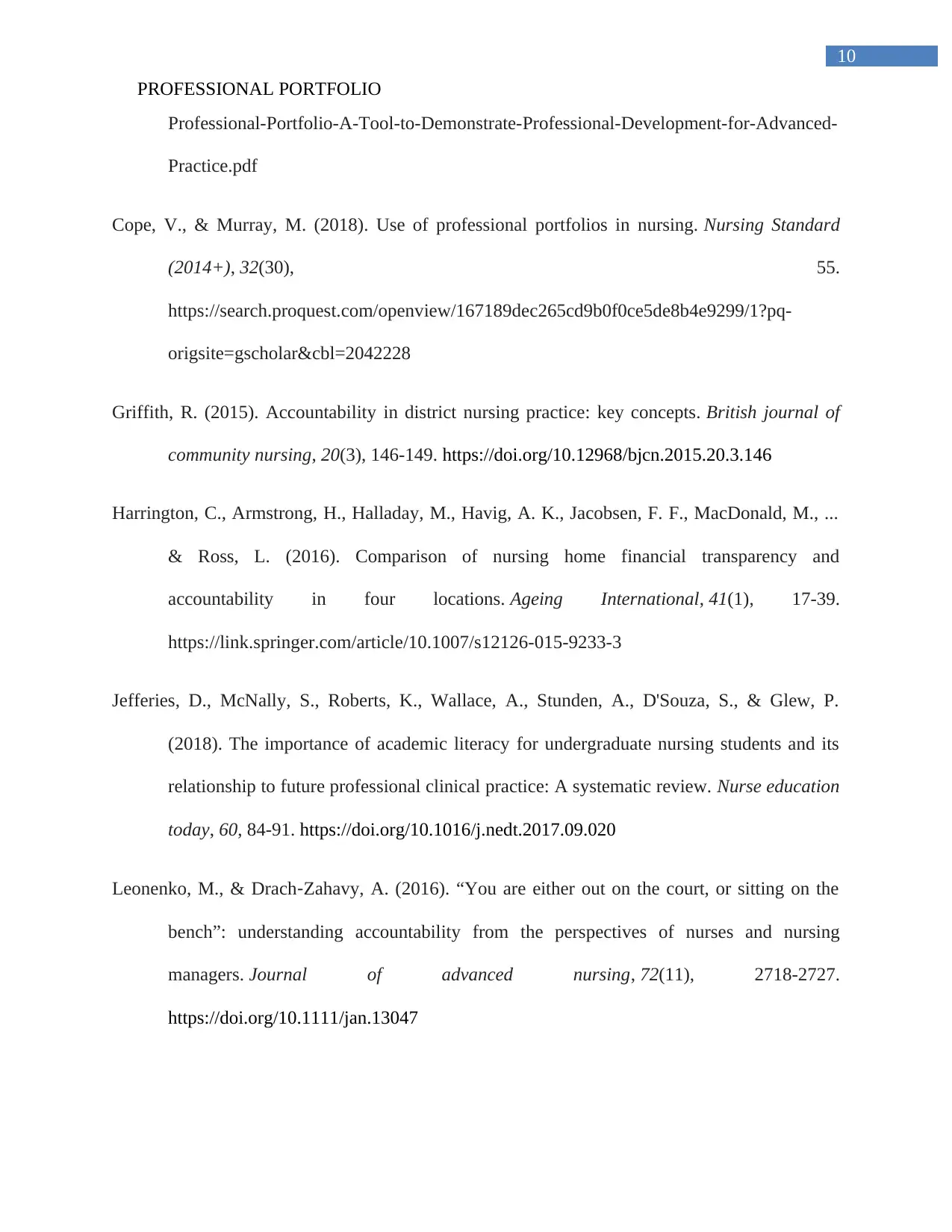
10
PROFESSIONAL PORTFOLIO
Professional-Portfolio-A-Tool-to-Demonstrate-Professional-Development-for-Advanced-
Practice.pdf
Cope, V., & Murray, M. (2018). Use of professional portfolios in nursing. Nursing Standard
(2014+), 32(30), 55.
https://search.proquest.com/openview/167189dec265cd9b0f0ce5de8b4e9299/1?pq-
origsite=gscholar&cbl=2042228
Griffith, R. (2015). Accountability in district nursing practice: key concepts. British journal of
community nursing, 20(3), 146-149. https://doi.org/10.12968/bjcn.2015.20.3.146
Harrington, C., Armstrong, H., Halladay, M., Havig, A. K., Jacobsen, F. F., MacDonald, M., ...
& Ross, L. (2016). Comparison of nursing home financial transparency and
accountability in four locations. Ageing International, 41(1), 17-39.
https://link.springer.com/article/10.1007/s12126-015-9233-3
Jefferies, D., McNally, S., Roberts, K., Wallace, A., Stunden, A., D'Souza, S., & Glew, P.
(2018). The importance of academic literacy for undergraduate nursing students and its
relationship to future professional clinical practice: A systematic review. Nurse education
today, 60, 84-91. https://doi.org/10.1016/j.nedt.2017.09.020
Leonenko, M., & Drach‐Zahavy, A. (2016). “You are either out on the court, or sitting on the
bench”: understanding accountability from the perspectives of nurses and nursing
managers. Journal of advanced nursing, 72(11), 2718-2727.
https://doi.org/10.1111/jan.13047
PROFESSIONAL PORTFOLIO
Professional-Portfolio-A-Tool-to-Demonstrate-Professional-Development-for-Advanced-
Practice.pdf
Cope, V., & Murray, M. (2018). Use of professional portfolios in nursing. Nursing Standard
(2014+), 32(30), 55.
https://search.proquest.com/openview/167189dec265cd9b0f0ce5de8b4e9299/1?pq-
origsite=gscholar&cbl=2042228
Griffith, R. (2015). Accountability in district nursing practice: key concepts. British journal of
community nursing, 20(3), 146-149. https://doi.org/10.12968/bjcn.2015.20.3.146
Harrington, C., Armstrong, H., Halladay, M., Havig, A. K., Jacobsen, F. F., MacDonald, M., ...
& Ross, L. (2016). Comparison of nursing home financial transparency and
accountability in four locations. Ageing International, 41(1), 17-39.
https://link.springer.com/article/10.1007/s12126-015-9233-3
Jefferies, D., McNally, S., Roberts, K., Wallace, A., Stunden, A., D'Souza, S., & Glew, P.
(2018). The importance of academic literacy for undergraduate nursing students and its
relationship to future professional clinical practice: A systematic review. Nurse education
today, 60, 84-91. https://doi.org/10.1016/j.nedt.2017.09.020
Leonenko, M., & Drach‐Zahavy, A. (2016). “You are either out on the court, or sitting on the
bench”: understanding accountability from the perspectives of nurses and nursing
managers. Journal of advanced nursing, 72(11), 2718-2727.
https://doi.org/10.1111/jan.13047
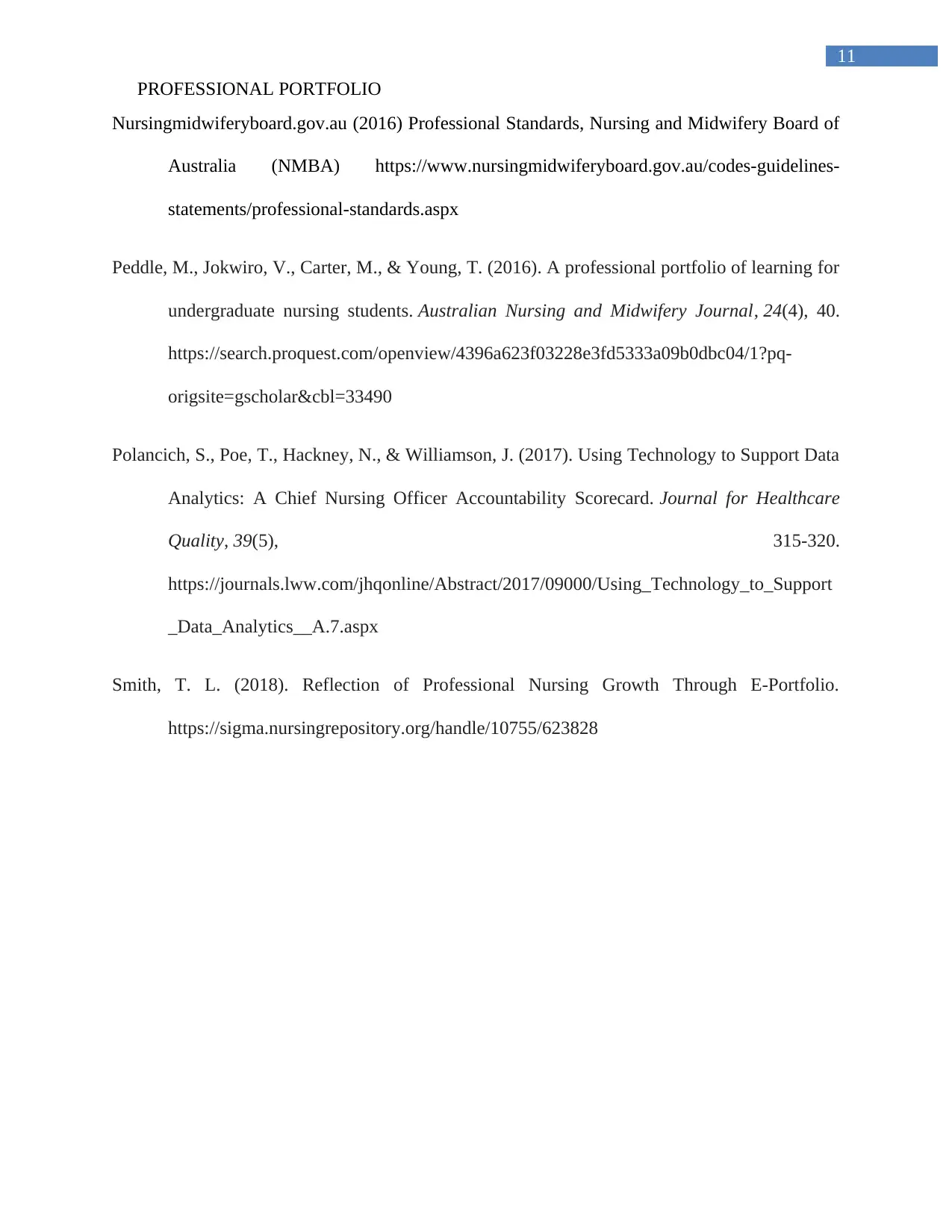
11
PROFESSIONAL PORTFOLIO
Nursingmidwiferyboard.gov.au (2016) Professional Standards, Nursing and Midwifery Board of
Australia (NMBA) https://www.nursingmidwiferyboard.gov.au/codes-guidelines-
statements/professional-standards.aspx
Peddle, M., Jokwiro, V., Carter, M., & Young, T. (2016). A professional portfolio of learning for
undergraduate nursing students. Australian Nursing and Midwifery Journal, 24(4), 40.
https://search.proquest.com/openview/4396a623f03228e3fd5333a09b0dbc04/1?pq-
origsite=gscholar&cbl=33490
Polancich, S., Poe, T., Hackney, N., & Williamson, J. (2017). Using Technology to Support Data
Analytics: A Chief Nursing Officer Accountability Scorecard. Journal for Healthcare
Quality, 39(5), 315-320.
https://journals.lww.com/jhqonline/Abstract/2017/09000/Using_Technology_to_Support
_Data_Analytics__A.7.aspx
Smith, T. L. (2018). Reflection of Professional Nursing Growth Through E-Portfolio.
https://sigma.nursingrepository.org/handle/10755/623828
PROFESSIONAL PORTFOLIO
Nursingmidwiferyboard.gov.au (2016) Professional Standards, Nursing and Midwifery Board of
Australia (NMBA) https://www.nursingmidwiferyboard.gov.au/codes-guidelines-
statements/professional-standards.aspx
Peddle, M., Jokwiro, V., Carter, M., & Young, T. (2016). A professional portfolio of learning for
undergraduate nursing students. Australian Nursing and Midwifery Journal, 24(4), 40.
https://search.proquest.com/openview/4396a623f03228e3fd5333a09b0dbc04/1?pq-
origsite=gscholar&cbl=33490
Polancich, S., Poe, T., Hackney, N., & Williamson, J. (2017). Using Technology to Support Data
Analytics: A Chief Nursing Officer Accountability Scorecard. Journal for Healthcare
Quality, 39(5), 315-320.
https://journals.lww.com/jhqonline/Abstract/2017/09000/Using_Technology_to_Support
_Data_Analytics__A.7.aspx
Smith, T. L. (2018). Reflection of Professional Nursing Growth Through E-Portfolio.
https://sigma.nursingrepository.org/handle/10755/623828
⊘ This is a preview!⊘
Do you want full access?
Subscribe today to unlock all pages.

Trusted by 1+ million students worldwide
1 out of 12
Related Documents
Your All-in-One AI-Powered Toolkit for Academic Success.
+13062052269
info@desklib.com
Available 24*7 on WhatsApp / Email
![[object Object]](/_next/static/media/star-bottom.7253800d.svg)
Unlock your academic potential
Copyright © 2020–2025 A2Z Services. All Rights Reserved. Developed and managed by ZUCOL.





